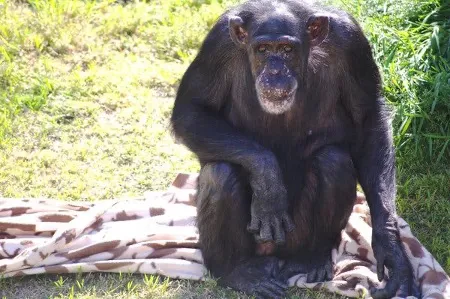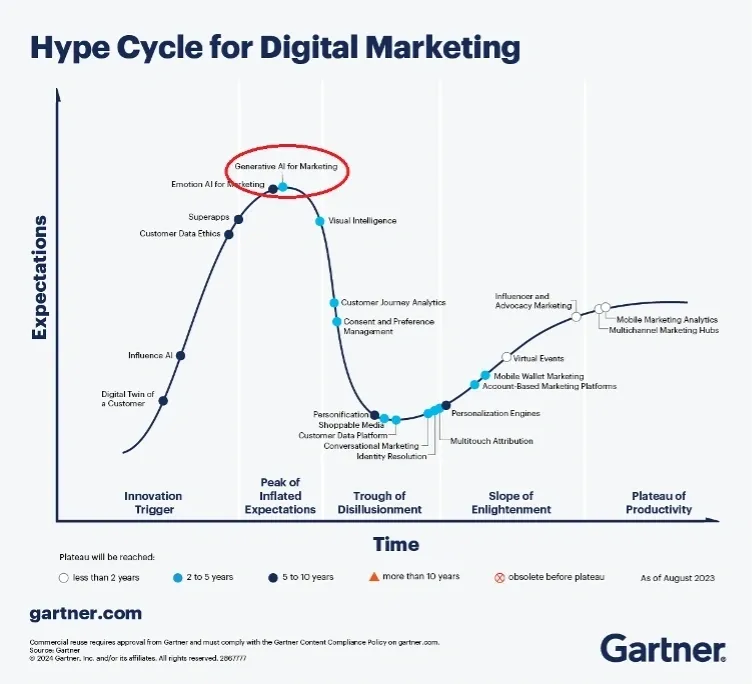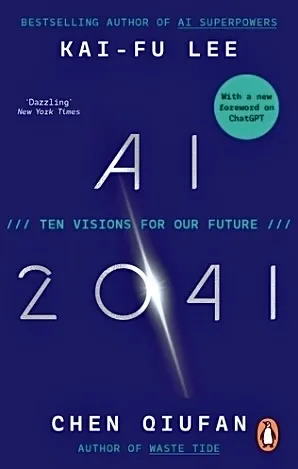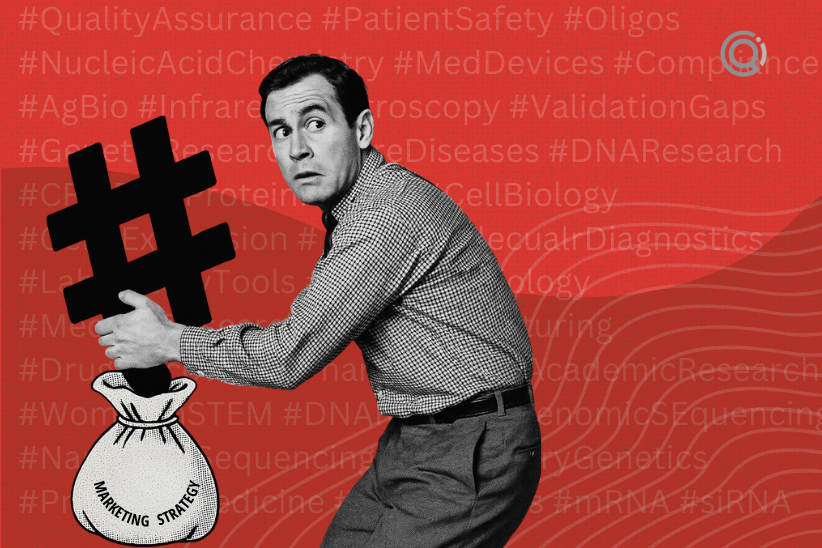Journalists and content marketers – don’t pack up your laptops any time soon. AI may increasingly have all the answers, but to deliver true value to audiences we still need humans to ask the right questions.
“Why are dogs better than cats?” “Would a shark win in a fight against a crocodile?” “Why do we go to sleep?”
These are some of the hundreds (thousands?) of questions that my youngest son Leo asked me in his early years. It is an experience shared by parents the world over, and one that speaks to the innate curiosity of humans.
Some experts even say our ability to ask questions is what separates us from animals. David Premack and Ann James Premack began studying apes and their ability to communicate with humans in the 1970s. They worked with Sarah, seen in the image below, which the New York Times called ‘The World’s Smartest Ape’. According to their research Sarah became increasingly proficient at responding to questions such as ‘which is the red apple?’ But despite trying for many years the Premacks were never successful at prompting Sarah to ask true questions.
As with Sarah, in the last decade AI has become highly capable at providing answers. In many cases it is even better at doing so than humans. For instance, Google can tell me the best keywords to use for search advertising by harnessing the power of its neural networks.

As with Sarah, in the last decade AI has become highly capable at providing answers. In many cases it is even better at doing so than humans. For instance, Google can tell me the best keywords to use for search advertising by harnessing the power of its neural networks.
It can also inform me, via predictive analytics tools such as Qualtrics and DataRobot, which kinds of content a specific audience finds most relevant, or which channels I can use to boost my chances of lead conversion.
Computer brains at the heart of marketing automation software such as Marketo and Hubspot can respond to more complex questions such as “what is the optimal sequence of interactions required to turn a prospect into a fully-qualified lead?”
In recent years, thanks to the rise of Gen-AI, computers are also able to provide answers in the form of new content. This could be a scientific article, an explainer video or an eye-catching infographic. They can also develop engaging interactive material including polls, surveys – and even create the code for online games.
This new creative capability for AI has led many people, particularly in the media and marketing industries, to ask whether the days of journalists and other content creators are numbered.
AI has already established a foothold in the office and the newsroom. Many marketers are employing Chat GPT to craft the first draft of an article or a scientific paper. Media companies are actively hiring AI professionals and coupling up with AI-based organisations.
The latest to do so is News Corp, which has just signed a partnership with OpenAI, prompting Robert Thompson, chief executive of News Corp, to say: “We are delighted to have found principled partners in Sam Altman and his trusty, talented team who understand the commercial and social significance of journalists and journalism.”
Despite the deafening noise around, the technology machines are not about to replace journalists and marketers any time soon. Gartner, the research and consulting firm, says the hype around Gen AI is at what it calls the ‘Peak of Inflated Expectations’. The most recent edition of its Hype Cycle for Digital Marketing predicts that the discussion will at some point descend into what it calls the ‘Trough of Disillusionment’.

This rings true with most people’s real-world experience of Gen AI. They see it as an increasingly useful tool, but they would not trust it to fully develop new content from start to finish. Sometimes the text produced by Chat GPT feels clunky or even makes simple vocabulary or grammatical mistakes. Often, it does not sound quite human, and it always needs to be checked by a person for scientific or legal accuracy.
A three-phase process
One way of structuring AI’s role is as part of a three-phase process. In the first phase the marketer or journalist provides AI with the structure of a potential article, together with the context and the raw data. In phase 2 AI produces the initial and subsequent drafts, with feedback from the marketer or journalist. Finally, in phase 3 the human fully edits and checks the article to ensure it adopts a human tone of voice, is factually correct and legally watertight.
In terms of the above process, it is only a matter of time before AI gets dramatically better at phases 2 and 3. AI excels at (machine) learning, and by design it acquires knowledge at an accelerated rate. We are still in the baby steps of the AI content journey and tools such as Chat GPT and Bard are growing up rapidly. Take image creation as an example. Historically, AI has struggled with creating detailed features such as hands, but recent iterations of image creators such as Midjourney have started to overcome this problem.
There is no reason to think that AI-created articles cannot sound perfectly human as the computer continues to learn what human sounds like. AI will also supersede humans in its ability to spot factual issues or legal minefields, much as it out-performs cancer diagnosticians in their ability to identify breast cancer from scans.

In the book AI 2041 Kai-Fu Li and Chen Quifan show us a world in which it is virtually impossible to distinguish a deep fake from the real thing. It says “In the early days of deepfake technology, factors like internet speed and exaggerated expressions could easily cause glitches, resulting in images that blurred, or out-of-sync lip movement. Even if the glitch lasted for only 0.05 seconds, the human brain, after millions of years of evolution, could sense something was amiss. By 2041, however, DeepMask—the successor of deepfake—had achieved a degree of image verisimilitude and synchronization that could fool the human eye.”
Questions and curiosity
But what of phase 1 of the process – AI’s ability to provide the initial idea and direction? This is where things become a lot more interesting, and it returns us to the difference between questions and answers.
As technology continues to advance it seems that AI will increasingly have the solutions to most of the questions we pose. In the end, answering questions for AI comes down to generating new data based on existing data. Text, pictures, videos and even computer code are just constructs of data that AI can assemble based on what it has observed in the world. And as we have seen, generating new data based on existing data is what AI excels at.
But phase 1 of the process detailed above – the ability to ask a true question – is where AI, as with Sarah the ape, comes unstuck. This is because it cannot ask questions outside of the current reality. Of course, Chat GPT asks questions for clarity, to help solve a problem, to gather context or to receive instructions. But it does not ask the initial question – the true ‘why’. These kinds of questions cannot be generated by our current experience or any set of existing data.
In her article, Anne-Laure Le Cunff, the Founder of Ness Labs, makes the distinction between human curiosity and AI curiosity. For her, human curiosity is intuitive and intrinsic in the sense that it values open-ended creativity and knowledge for its own sake. In contrast, she describes AI curiosity as computative and extrinsic, focusing on finding specific, practical solutions to well-defined problems.
She says this means that “humans are capable of making serendipitous discoveries through non-obvious connections” and she adds that “this intuitive processing is what allowed Alexander Fleming to notice that a contaminated Petri dish containing Staphylococcus bacteria had been inhibited by the growth of a mould, resulting in the discovery of penicillin in 1928 and the development of antibiotics.”
Mapping the future for content creators
What does this all mean for journalists and content marketers? They will, in time, face a revolution where many of their current tasks – the actual crafting and refining of the content – will be taken over by AI. This may not happen as swiftly as some people expect, but it is naive to think this will not happen at all as AI makes advances in years to come.
It also brings to the fore the need for journalists and marketers to become accomplished at shaping and reshaping appropriate prompts for AI, to accelerate the process outlined in phases 1 and 2. Hubspot, in its article 70 AI Prompt Examples for Marketers to Use in 2024 says that “the right prompts are essential to make the most of AI’s capabilities” and it goes on to share examples of prompts that marketers can use.
But the reality is that while journalists and marketers need to get better at asking the right questions to enable Gen AI to produce content – it is still humans that will be asking the questions. At the heart of the creative process is the ability to ask ‘why’ and that is something that Gen-AI simply cannot replicate, however much data it has access to.
It may be an artist looking at an object in a novel way, a reporter digging around for a scoop or a content marketer coming up with an idea for a breakthrough campaign. All these things come down to humans asking questions, and these are questions which AI simply cannot ask because it lacks the type of curiosity that Anne-Laure Le Cunff calls intuitive and intrinsic.
Scientists are still trying to understand where human curiosity comes from – it seems linked to the neurotransmitter dopamine and may also be related to consciousness. But what seems clear is that the path that AI is on right now, while groundbreaking in so many ways, will never lead to the establishing of a human-type curiosity.
Maybe this will change and in a distant future AI will become self-aware and start wondering about the world in which it operates. But for now, asking true questions will remain the preserve of human beings – and small children all over the world will continue to ask why red cars go faster and why water is wet.
Hi I’m Arun

I am an experienced marketing leader with a background in demand generation, ecommerce and digital. I enable companies to operationalise the latest innovations, including GenAI, and transform their commercial operations, securing senior stakeholder support throughout the process.
To do this I draw on my experience initially as a senior journalist, then a consultant and latterly an executive in the life sciences industry. My leadership journey has taken me around the globe, including eight years in Hong Kong and four years in Amsterdam. This international exposure has honed my ability to lead diverse teams and navigate cultural nuances.
Should you wish to find out more about how to develop differentiated strategies for content marketing, or to leverage GenAI for scientific content creation, please contact us at hello@qincade.com. Qincade’s marketing and digital experts will work closely with you to efficiently generate scientific materials while maintaining the integrity and validity of the content from a technical, regulatory and legal point of view.
By: Arun Mahtani, Qincade Advisory Board Member





